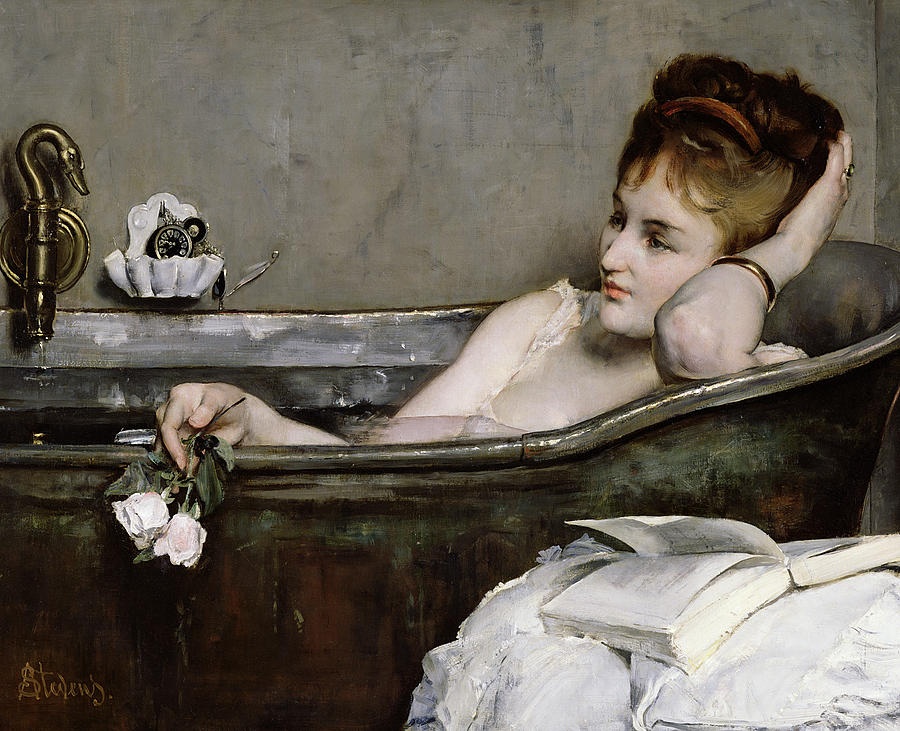
Le Bain, 1880c
Born in Belgium on the 11th of May, 1823 Alfred Stevens was a painter of modern women from the mid-1800's. While successful in his own day in terms of sales, nowadays he is largely unknown and somewhat dated, yet his work carries a certain poetic quality at times that is worth investigating. There is a freshness and spontaneity in his brush that is not commonly seen in other artists, particularly in his era. Although he comes from a strong Classical tradition, Stevens makes effective use of fashion and character in his portraiture with a timelessness, an ability to capture a moment in time like a photograph, but not photographic at all.
In Le Bain above, a woman is lost in though while laying fully clothed in a bathtub of water. She casually holds white flowers in her hand while an open book sits on a pillow beside her. Note the texture of the bathtub in its dark, warm hues that Stevens renders here. Despite this unusual theme the young woman appears carefree and relaxed. When I saw this at the musee d'Orsay last year I marvelled at the seamless grey skintones on her arm and face. This kind of narrative is sadly lacking in today's stoic realism.

The New Blue Ribbon, 1850c
I admire Stevens' blatant simplicity. There really is not much of a narrative here, yet the immediacy and presence is so strong that at first glance it seems vacant, but stare at it longer and you are mesmerized. This is not especially an interesting composition either. However, the soft light and the woman looking at us with those imploring eyes...there is a sense that we already know her and why she is standing there. Stevens uses a flower motif again, more for visual interest than anything, yet it is this young woman who needs no reason to be here and yet we want her to. This is the work of a painter with an intelligence and subtlety that defies description.

Autumn Flowers, 1867
I love this low-key, morose type of painting. Zoom in on the drapery of the blacks and greys and you can see the brushwork is confident, yet not overly detailed. Note how Stevens uses unusual accents of yellows and greens, even blue in certain spots, to suggest ornate details in this dramatic outfit. Zoom out and the details seem to be magic. Again, the flower motif is quite prominent here, and I am not sure of the meaning in this particular choice of bouquet but change and maturity are strongly suggested here. The woman's face here has the Classical presence of a Veronese, and I like the way he has scumbled warm tones on top of the cool underpainting in her skin.

La Fillette aux canards , 1881
Stevens is a master of charm and perception. Here, some may deem this as sentimental but there is an honesty to his work that is not insincere or showy. This is a real moment, and the way Stevens uses his palette of reds and greens, while contrasting a light foreground with a darker background is visually astute. Placing the young girl in the near center of the composition is bold and risky, yet Stevens counterbalances this with a young mother off to the right who watches her daughter adoringly. The brushwork here is incredibly simplistic. Stevens uses strong body language and mood to convey a simple narrative that anyone can understand and appreciate.

L'Étude du Rôle, 1888
Placing his subject near dead center of the composition once again, Stevens creates mood and presence in a simple study of a young woman posing in front of the mirror. There is something so real and tangible in this moment, with the sun shining outside and the striped yellow and white window cover that we feel we are in the late 1800's in this room, standing not far away from this pretty young art model.
Stevens did not believe necessarily in stature or social standing, but presence, in all of his portraiture. Being is more important than who you are. Mindfulness as the essence of art. This Belgian painter may not be remembered today, but he should. What he was able to utilize can teach all of us.
Comments
Post a Comment